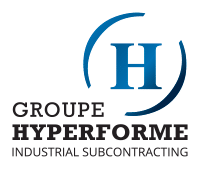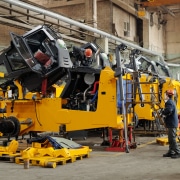When it comes to coating metal surfaces, two popular methods stand out: E-coating and powder coating. Each method offers unique advantages and caters to specific application needs. In this article, we compare E-coating and powder coating, considering factors such as finish quality, cost, and suitability for various applications.
E-Coating and Powder Coating: Cutting-Edge Metal Finishing Options
Both E-coating and powder coating processes showcase unique characteristics that cater to different requirements. E-coating excels in providing a uniform, ultra-thin finish ideal for intricate shapes, while powder coating offers versatility in color options and textured finishes, making it a popular choice for a wide range of applications. Let’s delve deeper into the intricacies of these popular finishing methods.
E-coating, also known as electrodeposition coating, is a sophisticated method involving the immersion of metal parts into a bath of paint particles. In this process, an electrical current is applied, resulting in a unique and highly effective coating technique. The metal substrate becomes the cathode, attracting the charged paint particles to form a uniform and ultra-thin finish. One of the notable advantages of E-coating is its ability to provide excellent coverage, making it the ideal choice for intricate shapes and hard-to-reach areas.
The E-coating process is characterized by its precision, ensuring an even application of the coating across the entire surface. This uniformity is particularly beneficial in industries where visual appeal and protective properties are paramount. The electrocoating process offers an outstanding level of control, making it a preferred option for industries that require meticulous attention to detail in their finishing methods.
E-Coating Services
The powder coating process employs dry powder, which is applied to the metal substrate in a finely ground form. The application is facilitated by an electrostatic charge, causing the powder particles to adhere to the metal surface. This electrostatic attraction creates a durable finish with a distinct advantage – a wide range of color options. Powder coatings are renowned for their versatility, allowing manufacturers to achieve various finishes, including textured surfaces.
The powder coating process is not only efficient but also environmentally friendly. The absence of solvents and volatile organic compounds (VOCs) makes it a preferred choice in industries focused on sustainability. Additionally, the versatility of powder coatings extends to the ability to create visually appealing textures, enhancing the aesthetic appeal of finished products.
Powder Coating Services
Liquid Paint Coating
This process involves applying liquid paint directly to the surface using methods such as brushing, spraying, or dipping. This traditional painting method is often used to coat various materials and shapes. Liquid paint usually results in a thicker finish compared to E-coating and powder coating. These liquid coatings can be suitable for a wide range of materials but are less precise for intricate shapes.
Galvanization (Hot-Dip Galvanizing)
The galvanization process involves immersing metal parts in a bath of molten zinc to provide corrosion resistance. It offers additional corrosion protection, especially in harsh environments. On the downside, the finish will be less aesthetic compared to E-coating and powder coating.
8 Must-Know Solutions for Your Needs in Industrial Subcontracting
Choosing the Ideal Coating Application Method: Essential Factors to Consider
Choosing between E-coating and powder coating depends on specific application requirements, design considerations, and budget constraints. Both methods offer unique advantages, and manufacturers can leverage the evolving landscape of surface finishing technologies to meet their distinctive needs.
Finish Quality
E-Coating
The E-coating process boasts a unique process involving immersing metal parts in a bath of paint particles while applying an electrical current. The precision of the E-coating process ensures an even application, meeting high standards for visual appeal. This results in uniform, ultra-thin, and aesthetic finishes, making the e-coat paint process ideal for intricate shapes and hard-to-reach areas.
Powder Coating
Meanwhile, powder coating touch-ups rely on dry powder applied to the metal substrate through an electrostatic charge, creating a durable finish. The powder coating process ensures a uniform coating thickness, contributing to a visually appealing and robust finish. This method provides a wide range of color options and can achieve textured finishes, offering versatility in aesthetic appeal.
Cost Considerations
E-Coating
While the initial setup costs for E-coating are relatively higher, its long-term cost-effectiveness becomes evident. The durability and excellent corrosion resistance provided by E-coating make it an economical choice, especially in industries with specific design requirements and challenging environmental conditions.
Powder Coating
Powder coating is recognized for its efficiency and cost-effectiveness. The versatility in color options and the ability to achieve textured finishes make it a popular choice for manufacturers seeking an attractive yet durable coating solution. The cost benefits become more apparent in large-scale production scenarios.
Suitability of Application
E-Coating
E-coating stands out as the preferred option for applications requiring precision and protection against corrosion. Its ability to cover complex shapes and intricate geometries makes it an ideal choice for industries with specific design criteria. The electrical charge contributes not only to the application process but also enhances the overall adherence of the coating, resulting in a consistent and reliable finish.
Powder Coating
Powder coating’s versatility positions it as a suitable option for various materials, shapes, and industries. This process ensures that the coating conforms to the contours of the object, leaving no room for unevenness. Its environmentally friendly nature, along with the wide range of color options, caters to diverse aesthetic and design requirements.
Durability
E-Coating
E-coating stands out for its exceptional durability, providing a robust defense against the challenges of corrosion. The process of electrodeposition creates an ultra-thin finish that not only contributes to the longevity of the coating but also enhances the overall protection of the metal substrate. This durability makes E-coating an excellent choice for applications in harsh environmental conditions where corrosion resistance is paramount.
Powder Coating
Known for its versatility, powder coating also excels in durability. The electrostatically charged powder particles form a resilient finish that can withstand various environmental factors. Beyond durability, powder coating’s adaptability to different colors and textures enhances its appeal across industries. The combination of durability and aesthetic options makes it a preferred choice for applications where both performance and visual appeal are critical.
Environmental Impact
E-Coating
E-coating’s commitment to environmental friendliness is evident in its water-based solution. By utilizing water as the medium for the coating process, E-coating significantly reduces the use of solvents and VOCs. This not only contributes to a more sustainable approach but also minimizes the environmental impact associated with traditional coating methods.
Powder Coating
Powder coating takes a step further in environmental consciousness with its dry finishing process. The absence of solvents and VOCs makes powder coating an eco-friendly option. The powder overspray can be collected and reused, minimizing waste and reducing the overall environmental footprint. This sustainability aspect aligns with the growing demand for green practices in various industries.
What are the Applications of E-Coating?
Achieving Optimal Coating Results: The Benefits of Working Alongside a Contract Manufacturer
Achieving the best coating results is not just about the technology or materials used; it’s also about strategic partnerships. Working alongside a contract manufacturer specializing in coating processes offers a myriad of benefits that can elevate the quality, efficiency, and overall success of your production.
Expertise and Specialization
Contract manufacturers dedicated to coating processes bring a wealth of expertise and specialization to the table. Their teams are often composed of skilled professionals with in-depth knowledge of coating technologies, application methods, and industry-specific requirements. Leveraging this expertise ensures that your products receive the best-suited coating solutions tailored to your unique needs.
Cutting-Edge Technology and Equipment
Staying at the forefront of technological advancements in coating is a challenge for individual manufacturers. Contract manufacturers, on the other hand, invest heavily in state-of-the-art technology and equipment to maintain a competitive edge. Partnering with them provides access to cutting-edge coating methods and ensures that your products benefit from the latest innovations in the field.
Cost Efficiency and Scalability
Opting for in-house coating facilities can entail substantial capital investment, ongoing operational costs, and the burden of maintaining and upgrading equipment. Contract manufacturers, with their economies of scale, offer cost-efficient solutions. By outsourcing coating processes, you gain access to scalable services that can adapt to fluctuations in production volume without compromising quality.
Enhanced Quality Control and Consistency
Contract manufacturers prioritize quality control as a cornerstone of their services. With stringent processes in place, they ensure that each coated product meets the highest standards. The consistency achieved through their quality control measures translates to a reliable and uniform coating application across your entire product line.
Flexibility in Coating Options
Contract manufacturers often offer a diverse range of coating options, from traditional methods to advanced techniques like E-coating and powder coating. This flexibility allows you to choose the coating method that best suits your product specifications, design requirements, and industry standards, ensuring optimal results for your specific application.
Faster Time-to-Market
The streamlined processes and focused expertise of contract manufacturers contribute to shorter lead times and faster time-to-market for your coated products. Rapid turnaround times are crucial in meeting customer demands and maintaining a competitive edge in the market.
Groupe Hyperforme: A Unique Source of Expertise at Your Disposal
Welcome to Groupe Hyperforme, your comprehensive resource in industrial subcontracting. Our expertise spans various domains, providing turnkey solutions that yield solid results. By working alongside us, you gain access to our comprehensive suite of services:
Let’s join forces for superior performance, quality, and competitiveness. Explore our services, request a quote, and connect with us for a unique source of expertise at your disposal.
Contact us today
Learn More About Industrial Painting Applications
Powder Coating
Powder coating stands out as a versatile and efficient process, offering a wide range of color options and textured finishes. This method involves applying dry powder to the metal substrate, where powder particles are attracted by an electrostatic charge, resulting in a durable and visually appealing finish. The advantages of powder coating include accurate color representation, the benefits of color customization, and the ability to achieve uniform coverage on complex shapes and components. Additionally, powder coating touch-ups are practical, making it a preferred choice for industries seeking an attractive and robust coating solution.
E-Coating
E-coating, or electrodeposition coating, is recognized for its superior corrosion resistance and ultra-thin finish. The e-coat process involves immersing metal parts in a bath of paint particles while applying an electrical charge. This ensures uniform coverage, making it an excellent choice for hard-to-reach areas and intricate shapes. E-coat finishes provide a layer of protection against corrosion, and the anodic oxidation process contributes to outstanding durability. With an eco-friendly water-based solution, e-coating aligns with modern environmental conditions, making it suitable for various industries with specific design requirements.
Coating Processes
Industrial coatings encompass a variety of coating processes, including liquid coatings and traditional methods. Liquid paint applications using a spray gun are prevalent in many industries, offering a versatile solution for surface finishing. In contrast, the advancements in coating technologies have introduced water-based solutions, such as waterborne UV flatline coatings and cathodic electrodeposition (CED coating), reducing environmental impact. These coating processes cater to diverse needs in industrial applications and provide options for achieving a uniform thickness and finish.
Surface and Finish
Achieving a uniform finish is crucial in surface coating applications, whether it’s powder coating or e-coating. The goal is to provide durable and aesthetically pleasing results. The coating process enhances the overall appearance, offering aesthetic finishes with attractive color options. Uniform coverage is particularly critical for components with intricate shapes or irregular surfaces, ensuring a consistent and desired finish quality.
Metal and Substrate
Metal surfaces, including aluminum and galvanized steel, benefit from various coating methods to protect against corrosion. Zinc phosphate, anodic oxidation, and other coatings contribute to the durability and longevity of metal products. These protective layers play a crucial role in preventing rust and corrosion, making them a preferred choice in industries such as automotive, construction, and metal furniture manufacturing.
Corrosion and Protection
Corrosion resistance is a primary consideration in coating applications, with the goal of providing reliable protection against environmental factors. Coating materials, such as those used in e-coating and powder coating, form a protective layer that shields components from corrosion products and rust. This additional corrosion protection ensures the extended life of products, making them suitable for industries with stringent durability and resistance requirements.
Durability and Resistance
Durability is a key attribute in both powder coating and e-coating, offering exceptional resistance to wear and tear. These coatings provide long-term performance and maintenance requirements, making them ideal for industries where components are subject to harsh conditions, impact, or exposure to various elements. The outstanding durability ensures the products maintain their structural integrity and appearance over time.
Application and Components
Coating applications vary depending on specific requirements and industries. Industries with hard-to-reach areas or intricate shapes, such as the automotive sector, benefit from the precision and comprehensive coverage provided by e-coating and powder coating. These methods are versatile, covering a wide range of components and ensuring that each project meets its specific application needs.
Choice and Advantages
The choice between powder coating and e-coating depends on factors such as color preferences, project requirements, and environmental considerations. Powder coating offers advantages in terms of color customization and a wide range of color options, making it suitable for projects with diverse aesthetic requirements. On the other hand, e-coating provides superior corrosion resistance and is an ideal choice for projects where protection against corrosion is a primary concern.
Color and Aesthetics
Color plays a significant role in coating solutions, with powder coating offering a wide range of color options. These benefits of color customization enhance the aesthetic appearance of finished products, making them visually appealing. Whether it’s achieving a specific color or providing an attractive finish, the color options available in powder coating contribute to the overall visual appeal of components and products.
Environmentally Friendly
Modern coating solutions prioritize environmental friendliness, with both powder coating and e-coating incorporating eco-friendly practices. The water-based solution used in e-coating reduces environmental impact, aligning with green coating standards. Similarly, the dry finishing process in powder coating minimizes waste and emissions, making it an environmentally friendly choice for industries focused on sustainable coating solutions.
Electrical Charge
The application of an electrical charge is a common factor in both powder coating and e-coating. This charge ensures the adherence of coating particles to the metal surface, resulting in uniform finishes, all-encompassing coverage, and superior corrosion resistance. The use of an electrical charge is a crucial element that contributes to the effectiveness and efficiency of both coating methods.
Project and Equipment
Coating projects involve the careful selection of equipment and methods to achieve the desired finish and level of protection. Industrial equipment, such as spray guns and coating application systems, play a significant role in the success of coating projects. The choice of equipment depends on the specific requirements of the project, whether it involves coating complex geometries, recessed areas, or large-scale components.
Complex Shapes and Geometries
Coating methods like powder coating and e-coating excel in covering complex shapes and intricate geometries. These techniques ensure uniform coverage, even in irregular shapes or recessed areas, making them suitable for a wide range of components. Industries dealing with products featuring complex shapes benefit from the precision and effectiveness of these coating methods, achieving consistent and desired results.













